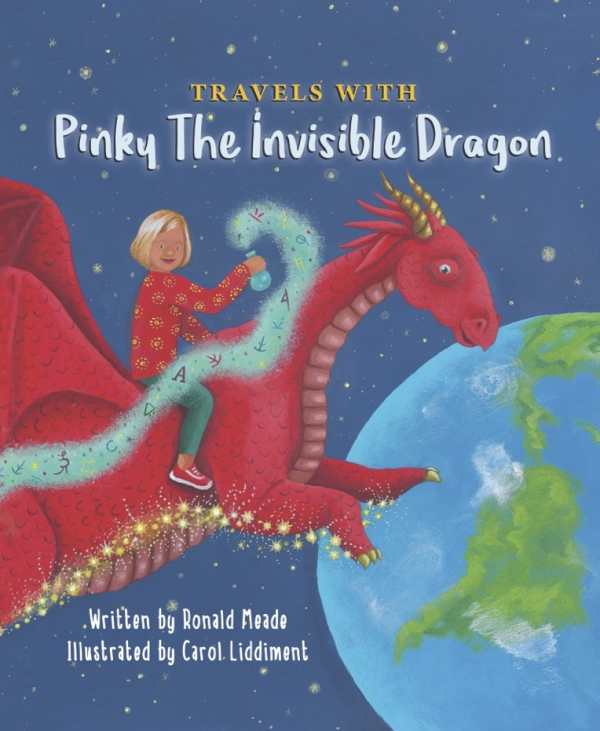
Travels with Pinky the Invisible Dragon
A lost girl sets off on an adventure to help her new forest-dwelling friends in this magical tale.
A girl chases her lizard friends into the rain forest and finds herself on a series of magical adventures in Ronald Meade’s early reader Travels with Pinky the Invisible Dragon.
An unnamed girl winds up lost after she chases her animal friends into the brush. The lizards are soon forgotten, though: the girl is rescued by a group of friendly monkeys, who show her how to forage and lead her around the forest, hoping to help her find her way home. Day after day, they fail, but that’s okay: the girl settles into the rhythms of rain forest life.
But this peace is disturbed when the animals and the girl encounter bulldozers tearing down the trees. The girl, who’s learned to love the creatures and their habitats, resolves to assist. She sets off to locate the wizards who are rumored to live nearby, and who might have a solution to the encroachment. In the process, she encounters a unicorn, traverses a volcano, locates a cave, and meets an elf, among other surprise developments. In a castle filled with wise and busy beings, she is advised that the key to stopping environmental destruction is cultural understanding. She is sent on a global, dragon-back adventure to observe people in other lands.
There are some holes, jumps, and inconsistencies in the narrative, though, from the girl’s general lack of concern about ever getting home, to her always tidy appearance despite months trampling through a variety of landscapes in the same outfit. That she doesn’t ask the humans she encounters for help is puzzling—as is the fact that she remains unnamed until the last page, though unnamed animals are promptly given monikers by her. Further, the book’s timeline is disjointed because of the unnecessary inclusion of holidays and celebrations at the castle, raising questions about the length of time that the girl spends in each visited place.
Even though talking animals are an early feature of the story, the introduction of wizards and castles to the mix in the second chapter is jarring, pulling the story from the realm of ecological interest and concern into that of magic. The balance shifts and reshifts throughout, particularly after the cultural observation element is added, impeding investment in the story and muddying the strength of its messages. The girl’s resolutions of her looming challenges—being lost; stopping the deforestation—are far too simple in comparison to the rest of her adventures. And the book’s errant punctuation, capitalization mistakes, redundant terms, and imprecise descriptions also undermine its work.
Despite the story’s loose, kitchen sink approach, the artwork stands to command attention. Carol Liddiment’s whimsical illustrations feature lush landscapes and bright details, like flowers on trees, whorls in the clouds, and delectable treats. The animals the girl encounters are drawn as a smiling and friendly bunch, though one helpful alligator has strange, patchwork skin. The girl’s features are often the most blurry parts of the illustrations, distracting from the wonders around her; and her proportions are off in some scenes, as when she rides a flamingo across a river, or climbs a camel at an oasis. The same is true of other human (and human-adjacent) beings in the book, who are awkward fits in the otherwise enchanting scenes they’re in.
A lost girl sets off on an adventure to help her new forest-dwelling friends in the early reader Travels with Pinky the Invisible Dragon.
Reviewed by
Michelle Anne Schingler
Disclosure: This article is not an endorsement, but a review. The publisher of this book provided free copies of the book and paid a small fee to have their book reviewed by a professional reviewer. Foreword Reviews and Clarion Reviews make no guarantee that the publisher will receive a positive review. Foreword Magazine, Inc. is disclosing this in accordance with the Federal Trade Commission’s 16 CFR, Part 255.
